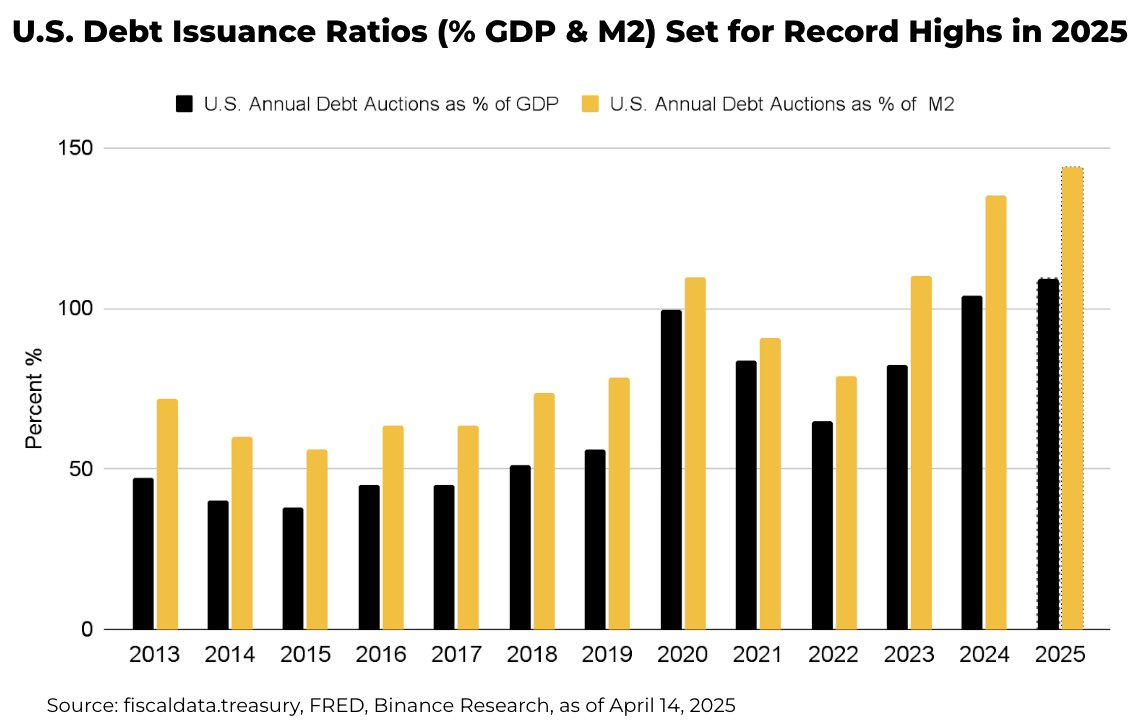-
The recent announcement of a record $31 trillion in US Treasury issuance has sparked concerns about its impact on the crypto market, particularly Bitcoin and Ethereum.
-
As foreign demand for US debt fluctuates, the potential for heightened yields and a stronger dollar could pose challenges for risk assets like cryptocurrencies.
-
According to Binance Research, “Persistent upward pressure on rates from Treasury supply could weigh on risk assets—crypto included,” emphasizing the delicate balance within the market.
This article analyzes the implications of the US Treasury’s $31 trillion bond issuance on the crypto market, particularly focusing on yield impacts and investor behavior.
Record US Treasury Issuance: Implications for Crypto Valuation
The US Treasury’s decision to issue over $31 trillion in bonds this year—representing around 109% of GDP—has raised significant questions regarding its implications for the crypto market. With bond issuance at an all-time high, there is a potential for rising yields, which could diminish the appeal of non-yielding assets like Bitcoin and Ethereum.
Heavy supply pressures might lead to increasing yields, as Treasury financing needs surpass demand. Higher yields raise the opportunity cost of holding cryptocurrencies, making them less attractively compared to traditional interest-bearing assets. This dynamic could draw capital from the crypto space into more secure investments.
Foreign Demand Dynamics: A Key Factor
Central to understanding the relationship between US bonds and the crypto market is the role of *foreign demand*. Approximately one-third of US debt is held by international investors. A decline in this demand, potentially driven by geopolitical factors or changes in global risk appetite, could compel the Treasury to offer steeper yields to attract buyers.
As yields increase, global liquidity may tighten, making riskier assets, including cryptocurrencies, less attractive. A historical parallel can be drawn from the 2022 bond market sell-off, where Bitcoin experienced a sharp decline alongside rising Treasury yields, dropping more than 50% during that period.

US Debt Issuance Ratio. Source: X/Binance Research
Moreover, as yields climb, the US dollar often strengthens, further complicating the situation for Bitcoin. A stronger dollar increases the USD-denominated price of Bitcoin for foreign buyers, potentially dampening international demand.
Crypto’s Unique Resilience: Hedge Against Inflation
Despite these challenges, Bitcoin and other cryptocurrencies possess unique attributes that may bolster their long-term appeal. During periods of extensive monetary expansion—evident post-pandemic—investors have increasingly turned to Bitcoin as a *hedge against inflation*.
While rising yields could dampen speculative inflows, the limited supply of Bitcoin alongside its decentralized nature may keep a base level of investor interest intact. Furthermore, Bitcoin’s correlation to yields could diminish if broader macroeconomic volatility arises from Treasury issuance fluctuations. Traders seeking portfolio diversification might turn to digital assets, as they often do not move in sync with traditional assets.
However, the effectiveness of this strategy depends significantly on ongoing institutional adoption and a supportive regulatory environment.
Conclusion: Navigating the Future of Crypto Amidst Rising Yields
The implications of record US Treasury supply for the crypto market underscore a complex relationship marked by volatility. As yields rise, cryptocurrencies may face significant headwinds, but their narrative as an inflation hedge and their evolving role in diversified portfolios might mitigate some of that volatility.
Market participants should keep a close watch on trends in foreign demand and evolving liquidity conditions, as these factors will be crucial in shaping crypto’s trajectory in the coming months.







